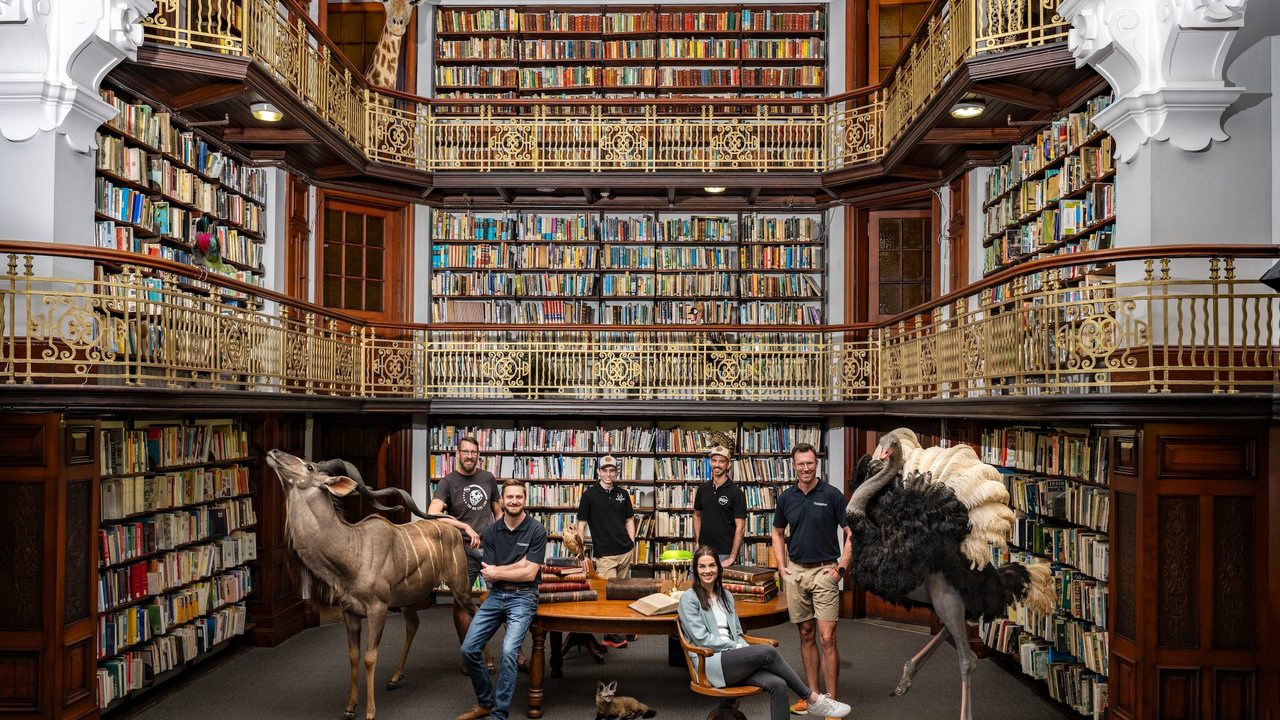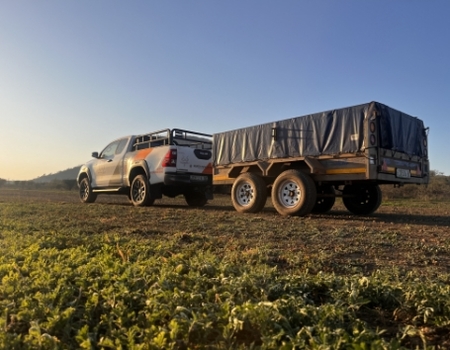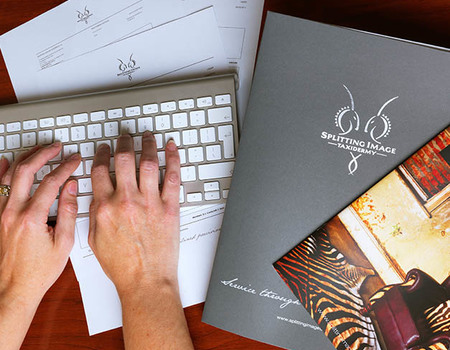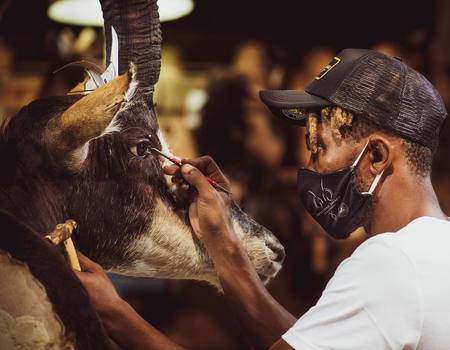
Our Cover Story
“A night at the library” was the concept of this year’s cover. In taxidermy we capture hunters’ memories and tell their adventure stories. Similarly, a library hold thousands of stories of experiences within its walls. We wanted to combine these concepts and have the stories coming to life on the front page.
We managed to secure an incredible location – a local municipal library that is closed for renovations but holds immense beauty and history.
Read how we made this possible as we chat with our head of Art, Travis de Villiers to discuss the process involved in creating the exceptional pieces.
First things first
I’ve never mounted an ostrich. So where do I start? And how do you go about it because everyone starts to build this image of what they think it’s going to look like in the end, and I’ve got to try and meet all those expectations and try pull it together. So, it was interesting, because they are quite flamboyant, you can do a lot with them, especially the neck, and all the feathers. It’s quite something else to do.
I think it’s possibly my favourite mount I’ve ever done, because it’s so challenging. The skin on the legs and body doesn’t really have stretch to it, it’s like working with leather. If you don’t get the anatomy part of it correct, you can’t give or take. There’s no give in the skin. All the patterns need to line up as well, so how you stitch it back together also matters. The scales of the skin, the patterns and the wrinkles on the skin are so defined. It’s also tedious working with it because you can’t bend and break feathers. You can’t accidently spill glue or anything on the feathers, because you’d destroy them. And in bird taxidermy you also get pin feathers, which are new feathers that are growing and those tend to fall out. You’ve got to memorise where they are so you can replace them, when you do the finishing part. So, all of that is quite intricate.
The pose we went for was flamboyant, and very in motion. It almost feels like it’s moving. It’s also on one leg, which is a bit of a challenge to mount and then obviously to have it freestanding in a library is another thing. I wanted to create a mount that you could look at from all angles and see something different as well. The neck for interest isn’t just straight up and down, it has curves to it from all sides. The pigmentation on the legs is what you see, the little tendons running down, the toes, the shape of the toes, and then the biggest thing after all that was the finishing - to get the colours right. So that was a lot of fun, I really enjoyed that part. I got to test my airbrushing skills again.
Technology and Technique
We decided to use our technology and 3D print the head, so that was also a fun aspect of it. We had a model of a head already that was a cast, but we thought it would be a good experiment to open its mouth digitally and then print it like that. And with the idea of it having a scarf in its mouth, we also needed to create a V shaped slot so that when you push the scarf in, it stays in and doesn’t slide right out. So that was just a small little detail that worked out in the end. Then, you’ve also got to carefully glue the skin around the shape of the beak and get that all in position and then blend it from the plastic printed part, into the real skin and make the transition disappear. It was fun, different. I’ve done something similar with mammals before, but never with a bird. You’ve got to study the anatomy, so you can figure out where everything belongs and why it’s there and then it makes complete sense, on anything.
The scales running up the legs were quite cool to paint. You need to airbrush every single one and try to keep it as unique to itself as possible. You’ll find in some of those scales is pigmentation – like black streaks coming through. So, you want to maintain that so that it keeps it as original as possible. And then you start to paint in purples and blues underneath the greys to bring that through. And then I did a little technique I was thinking about to make the skin look dry, which is to dust the skin afterwards with a very fine white powder and that goes into all the little cracks, so it looks like dry skin, because otherwise they look shiny and they’re not.
Conquering Challenges
One of the biggest challenges was finding a specimen. Time constraints are also a concern with a project like this. Ostriches take so long to dry. Their skin doesn’t have pores like ours, so moisture doesn’t move in and out of it. You must constantly work it and check it to make sure it holds the points that you want and the definition you want to see in the final product. It can be over defined or underdefined. If you’re pinning something, because of the type of skin, you wouldn’t want the definite print of ropes and pins to follow through into the mount. You need to take that off at the right time but also make sure that those points you’re trying to hold down, stay like that. With mammals it’s a lot different, they take much quicker to dry, and they tend to hold that shape and that form much better. You’ve also got to work gently. Standing next to it, it’s over 7 foot tall. When they stand fully straight up, they’re 9 feet tall. They’re massive animals, so it’s a balancing act. Feathers can fall out very easily, and these need to be replaced. You need to map out where they were and then pop them in one for one and orientate them correctly back to where they were.
Logistics
To get it to stand on one foot we had to use lots of steel work – but you have to be clever about it. The legs are only so thick, you can’t overdo it. Also, how you pose the leg will also determine how much steelwork you can accommodate, and you needed quite a bit in there to keep it nice and steady. Then we had it on a steel base plate for the weight, so that it doesn’t topple over.
Getting the mounts into the library was very tricky. Getting stuff up to the third floor, was one of the challenges, so we had a three-man pulley system. Fortunately, the mounts are not that heavy because we use polyurethane foam, but they’re awkwardly big because they are big animals. And you don’t want them to get damaged or to damage the library. You must be aware of what you’re doing. You don’t want accidents to happen, for someone to get hurt while you’re hoisting something in the air or for the mount to fall and get broken, that would be the worst-case scenario. It was fairly simple to do, it was more about caution not to damage anything. Having a good team – it was smooth and effortless. Everything worked in synch as it should, on time.
Teamwork
It was fun working with different people again. On big projects like this I tend to work with a lot of people. I don’t just sit and mount the stuff all day, in actual fact I’m working with the tannery department, and making sure the skins are right as I need them. Then I got to work one on one with the taxidermist on the floor, as an assistant here, and then on the next project, a different assistant, and then people that sew, and then going through finishing, then to crate it. Then working with the librarians, the photographers and assistants. We went to the venue to actually measure up the scene in the museum, where every mount is going to be, to make sure everything fits very well. So, it was really a collaborative process. It was a lot of steps to get to the end result, but we worked very well as a team on all fronts and I’m really excited to see the final result.






